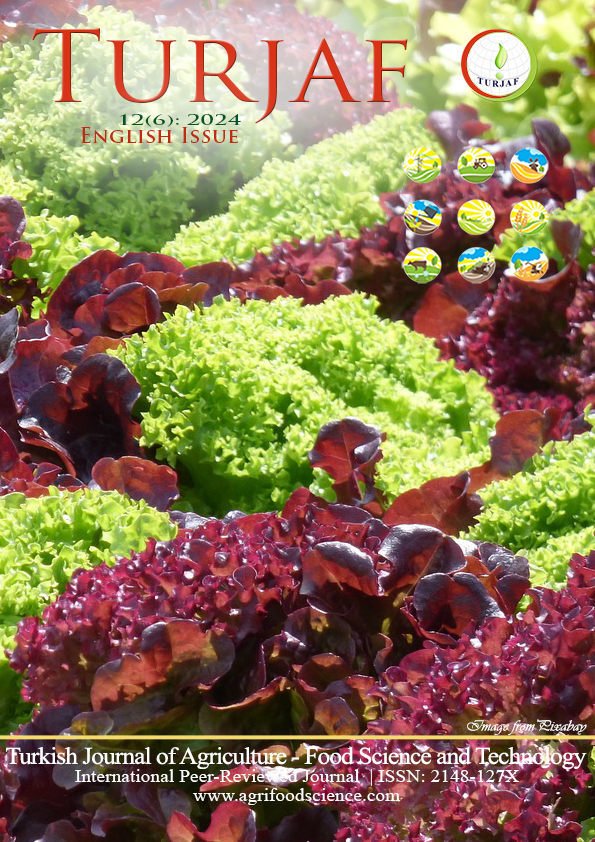A Comprehensive Study on the Agronomic and Technological Responses of Different Chamomile (Matricaria recutita L.) Varieties at Diverse Sowing Times
DOI:
https://doi.org/10.24925/turjaf.v12i6.1019-1025.6556Anahtar Kelimeler:
Variety- cultivar- Bodegold- Zloty Lan- essential oil- agronomic- active constituents- oil components- flower yieldÖzet
In this study, it was aimed to determine the effects of different sowing times and different varieties of German chamomilla (Matricaria recutita L.) on agronomic and technological characteristics. The study was conducted in experimental fields of the Department of Field Crops, Faculty of Agriculture in Adnan Menderes University. Two different tetraploid Matricaria recutita L. (Bodegold and Zloty Lan) cultivars were used for this study. Zloty Lan was provided by Germany and Bodegold was provided from Atatürk Central Horticultural Research Institute. The trial was conducted according to a split plot experimental design with 4 block. Factors consist of 5 sowing times as main plots (1 October, 15 October, 1 November, 15 November, 1 December) and 2 genotypes as subplots (Bodegold and Zloty Lan). The effect of sowing times and genotypes was found statistically significant on fresh flower yield. The highest flower yield was found 61.61 kg da-1 . The average values for plant height ranged from 45.43 to 55.20 cm, flower diameter ranged from 25.24 to 27.53 mm, biomass ranged from 130 to 332.3 kg da-1, fresh flower yield ranged from 19.74 to 61.61 kg da-1 , drug herb ranged from 35.5 to 73.5 kg da-1 , drug flower ranged from 7.4 to 13.3 kg da-1 , essential oil content ranged from 0.025% to 0.083% and essential oil yield ranged from 0.020 to 0.090 l da-1. The primary constituents of essential oil have been discovered as bisabolol oxide a and bisabolene oxide.
Referanslar
Arslan, D. (2012). Yalova ekolojik koşullarında mayıs papatyası (Matricaria recutita L.) çeşitlerinde farklı ekim zamanları ve ekim mesafelerinin verim ve kalite özelliklerine etkisi. Ege Üniversitesi, Fen Bilimleri Enstitüsü, Doktora Tezi, İzmir.
Azizi, M. (2007). Study of four improved cultivars of Matricaria chamomilla L. in climatic condition of Iran. Iranian Journal of Medicinal and Aromatic Plants Research, 22(4), 386-396.
Berimavandi, A. R., Hashemabadi, D., Ghaziani, M. V. F., & Kaviani, B. (2011). Effects of plant density and sowing date on the growth, flowering and quantity of essential oil of Calendula officinalis L. Journal of Medicinal Plant Research, 5(20), 5110-5115.
Ebadi, M., Azizi, M., Omidbaigi, R., Khayat, M., & Nadjafi, F. (2010). Effect of sowing date and harvest frequency on flower yield, essential oil percent and composition of chamomile (Matricaria recutita L.) CV. Presov. Planta Medica, 76, 213-226. https://doi.org/10.1055/S-0030-1264356.
Franke, R., & Schilcher, H. (2006, June). Relevance and use of chamomile (Matricaria recutita L.). In I International Symposium on Chamomile Research, Development and Production 749 (pp. 29-43).
Hadi-Seyed, M. H., Noormohammadi, G., Sinaki, J. M., Khodabandeh, N., Yasa, N., & Darzi, M. T. (2004). Effects of planting time and plant density on flower yield and active substance of Chamomile (Matricaria chamomilla L.). In Proceedings of the 4th International Crop Science Congress.
Kırımer, N. (2010). Tıbbi ve Aromatik Bitkisel Ürünlerin Üretimi ve Kalite Kontrolü, Anadolu Üniversitesi Yayınevi, pp. 136-148, Eskişehir.
Lubbe, A., & Verpoorte, R. (2011). Cultivation of medicinal and aromatic plants for specialty industrial materials. Industrial crops and products, 34(1), 785-801.
McKay, D. L., & Blumberg, J. B. (2006). A review of the bioactivity and potential health benefits of chamomile tea (Matricaria recutita L.). Phytotherapy Research: An International Journal Devoted to Pharmacological and Toxicological Evaluation of Natural Product Derivatives, 20(7), 519-530.
Mohammad, R., Hamid, S., & An, A. (2010). Effects of planting date and seedling age on agro-morphological characteristics, essential oil content and composition of German chamomile (Matricaria chamomilla L.) grown in Belgium. Industrial Crops and Products, 31(1), 145-152.
Moisiienko, V., & Nazarchyk, O. (2019). The dependence of the yield of medicinal chamomile inflorescences on the duration of the growing season of culture. Scientific Horizons. https://doi.org/10.33249/2663-2144-2020-86-1-7-13.
Nathan, M. .(1999). The complete german commission e monographs: therapeutic guide to herbal medicines. Annals of Internal Medicine, 130(5), 459. https://doi.org/10.7326/0003-4819-130-5-199903020-00024.
Rafieiolhossaini, M. (2010). Improving biomass production and qualify of German chamomile (Matricaria chamomilla L.) grown in Belgium (Doctoral dissertation, Ghent University).
Salamon, I. (2004). The Slovak gene pool of German chamomile (Matricaria recutita L.) and comparison in its parameters. Horticultural Science, 31(2), 70.
Salamon, I., Ghanavati, M., & Abrahimpour, F. (2010). Potential of medicinal plant production in Iran and variability of chamomile (Matricaria recutita L.) essential oil quality. Journal of Essential Oil Bearing Plants, 13(5), 638-643.
Singh, O., Khanam, Z., Misra, N., & Srivastava, M. K. (2011). Chamomile (Matricaria chamomilla L.): an overview. Pharmacognosy reviews, 5(9), 82.
Wagner, C., Friedt, W., Marquard, R. A., & Ordon, F. (2005). Molecular analyses on the genetic diversity and inheritance of (−)-α-bisabolol and chamazulene content in tetraploid chamomile (Chamomilla recutita (L.) Rausch.). Plant Science, 169(5), 917-927.
Wang, X., Ma, Y., Jin, Q., Yin, S., & Wang, S. (2020). Hepatoprotective effects of chamazulene against alcohol-induced liver damage by alleviation of oxidative stress in rat models. Open Life Sciences, 15(1), 251-258. https://doi.org/10.1515/biol-2020-0026
İndir
Yayınlanmış
Nasıl Atıf Yapılır
Sayı
Bölüm
Lisans
Bu çalışma Creative Commons Attribution-NonCommercial 4.0 International License ile lisanslanmıştır.

























